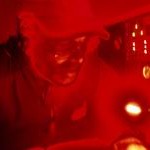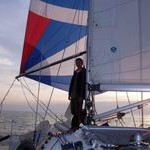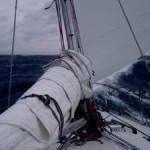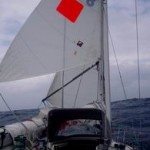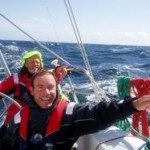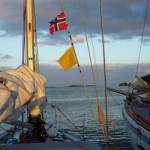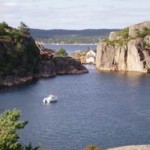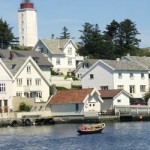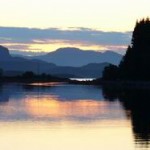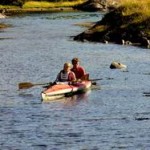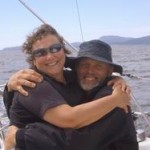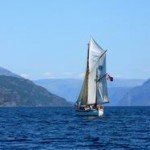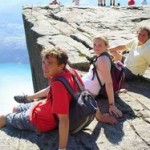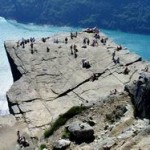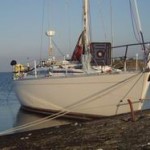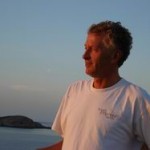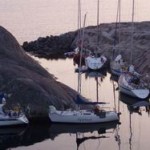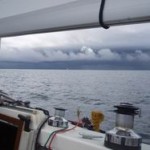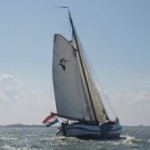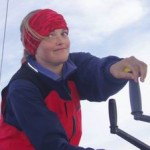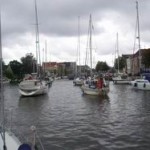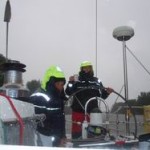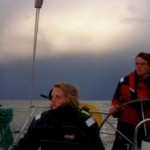2006 A Scandinavian Cruise
- Night time Nav
- Gale over the Dogger Bank
- Land Ho
- Ny Hellesund
- Kvitsoy
- Only a 2000m drop
- The Preikestolen
- Playing dodgems in Haarlem
Festina had been purchased with long distance cruising in mind, so earlier in the year I put the options to the crew of another Irish cruise taking in Corkweek, a hairy dash to the Faeroes or a trip to Norwaywith a view to increasing our experience of passage making prior to taking off for the wide blue yonder. The vote was for Norway. Graham volunteered for a delivery, Barney and Jonty were up for the trip across the North sea (although Jonty later had to drop out though work pressures) and Jaap seemed keen to “escape “ for a while and join us whilst we were there. My long suffering partners agreed to a months holiday, Ben was free to do the whole trip and so the project was agreed. As ever, having the idea is easy, but would we be able to complete such an ambitious trip in the short time available? All too soon it was time to find out.
The Delivery-1st JULY
Predictably the wind was dead on the nose as Graham Ben and I left Hamble at dusk on our delivery trip to the East coast, but it was obliging enough to let us motor to Selsey, fetch slowly overnight to Beachy Head and then thrash dead to windward in bright sunshine to Folkestone, where the twin incentives of a foul tide and empty bellies prompted us to motorsail into the lee of the cliffs and eat a prodigious supper. The wind fell light through the Downs but came up again at Bryony’s “corner“ (N. Foreland) allowing us to race North through the night on a brisk fetch.
Next morning the wind disappeared as the sun warmed up and we dribbled lazily along the Norfolkcoast before another fetch through the night to the Humber , a friendly Grimsbyharbour and a somewhat circuitous car journey home – but that’s another story.
The Passage- a week later
The car journey back the following weekend didn’t go altogether to plan either, with an enforced 4 hour stop in Nottingham to rebuild the charging/cooling system – but we still had time to lock out into a calm Humber and await the forecast Southerly gale that had cast a bit of a mental cloud over the preceding week. The spinnaker came down at 2300, by 0100 we had two reefs, the third came down an hour later, and by 0230 we were charging along under just a poled out No 3. For several hours the wind was a solid 30 knots with an hour or so around 0600 with a steady 35 – and of course pouring rain. We made the nice discovery that even in big seas the new autopilot steered a lot better than us and so from now on we just left it to get on with the job whilst we tended the sails.
Or not! Initially our course took us north of the rhumb to avoid the shallows of Dogger Bank (possibly unpleasant in this wind) and as the wind veered SW next evening so our course altered to keep the wind dead astern. The occasional breaking wave made life wet for the man on watch, but nothing dangerous came aboard. Sleeping was a bit of an art form as we rolled and pitched our way onwards, but the frequency was low and everyone’s stomachs seemed fine. By midnight the wind was down to 20 knots and veering to WNW so we hoisted the trysail as the boom would have been constantly in the water. The new motion proved more difficult with some awkward cross seas , and Barney succumbed, soon followed by Ben who was listening to Billy Connolly on his I-pod and crying with laughter and vomiting at the same time. Only a Scottish comedian could do that!
The 0530 shipping forecast suggested another Southerly gale coinciding with our arrival, soon turning Westerly. This would leave us arriving at a distinctly rocky coast in bad weather with the prospect of it becoming a lee shore. Nice! I reasoned that the South Norwegian coast might be less windy, especially if we entered the Skagerak close to Jutland and crossed over to the Norwegian shore once the wind had veered west. Kristiansandseemed to have the easiest entrance, so plan B was hatched, course altered and we rolled on our way.
The morning was spent in bright sunshine gradually piling on sail til we were once more under kite. We even motored for a few hours. Then the wind backed into the South, the sky began to cover and our third night mirrored the first with systematic reductions in sail – but very rapid progress towards the Skagerak whilst being entertained by various schools of silver grey dolphin and helpful watch keepers on passing ships who provided us with forecasts. Our third dawn brought heavy rain , more dolphins who entertained Ben with a spectacular display of leaping and tail slapping , and a Norwegian forecast of a 7, though we couldn’t quite understand when it was expected. For a while we rolled along under storm jib and trysail, but as we turned north to cross the Skagerak, the wind veered and the sky turned blue so we changed up jibs, hoisted the main and thrashed across towards the coast. Halfway across the wind was again 30 knots, causing us to take in the 3rd reef, but with 3 of us up to sail her and the land ahead no longer a lee shore , Festina charged along at nearly 8 knots in good spirits.
The southern Skjaergard looked wonderful in the afternoon sunshine. We moored alongside a beautiful Colin Archer yacht and a short walk ashore convinced the boys that 30 % of Norwegian girls look like Maria Sharapova, but the rest were far prettier. All in all it looked as if we had come to the right place!
An introduction to the Sjkaergard
Nothing happened the next day to change that view. Our neighbours were charming and showed us nice places to go on the chart , the boys visited the book shop and found the girls even prettier , and when I did eventually tear them away for a 10 mile beat through sparkling ( flat) water and myriad islands we all started salivating over the gorgeous gaily painted summer homes tucked away in innumerable little sheltered coves and bays- each with their own jetty , some with boat houses and all with the inevitable flagstaff and Norwegian pennant.
Our destination was Ny Hellesund , a perfectly sheltered natural harbour between two islands with two extremely narrow entrances . It was a deservedly popular place but never on the scale of Newtown. Most boats moored bows on to the rocks and some crews were camping on picture perfect grassy swards between the rocks and the trees . The whole area was free to moor or camp , kept spotlessly clean with well organised picnic tables and barbecues , loos and rubbish bins ,with an occasional visit from a warden boat but not a money collector in sight. We learnt that it is enshrined in law that the coast must be open to the people as a national resource. No wonder we don’t see any Norwegians visiting the UK.
We had surprising difficulty setting the anchor in the sandy mud , eventually settled for two, and were very glad of them as a front blew through in the night causing at least one boat to drag badly.
It was too nice an area to leave so we took Thursday off and launched the Klepper for the first time from the boat , using her to explore the nearby islands . When in Romeetc ( or in this case Norway) why not copy the natives. , Accordingly we joined our neighbours and moored bow on to the rocks for our second night , which felt very secure in the still fresh Westerly wind. Later that evening I climbed the 200 ft or so to the top of the island and gazed to windward over literally hundreds of other islands glistening under the setting sun. Amazingly even at this height, and despite being buffeted by the fresh wind I could smell the sea , mixed with the piny scent of trees , but above it all was a strong aroma of barbecues as seemingly the whole nation was spread out over the rocks cooking and enjoying themselves in the evening sunshine
Passage to the W Coast
It is amazing what changes 24 hours can bring. The forecast was for 20 knots from the NW , reducing overnight – not ideal when you want to go NW – but bearable. Lindesnes , or the Naze as the Brits called it is the roughest part of this coast but as we rounded the wind only went from 10 to 15 knots and it seemed a doddle. Within 20 minutes we had 20 knots but hoisted a No 2 on the assumption that this was as much as we were going to get. Later as we changed to the number 3 in 25 knots we had the same thought- but by 30 knots and the storm jib it dawned on us that we had a bit of a fight on our hands . By now the seas were horrid and the shore ( in particular the harbour of Lista ) , with its marking on the chart of “dangerous waves” seemed out of the question and the safest option seemed to be to head offshore to deep water. This was now the third time we had worn storm sails in 5 days Through the evening and night the boat sailed herself slowly to windward with the storm jib slightly over sheeted , the trysail slightly eased , the wheel locked and the anemometer reading a steady 35 knots. The seas were initially very confused – at one point the GPS gave up the unequal struggle of trying to keep track of its satellites and turned itself off, but after a while they became more benign and I began to enjoy myself. The nights at these latitudes were never particularly dark , the Northern horizon always being lit up , but on this occasion the clear sky and full moon meant that it remained as clear as day ,which added to the grandeur of the scene . All forecasts were promising lightish winds for the following day and the barometer peaked at 1031 so it was only a matter of time , and sure enough by 0200 the wind levelled out at 20 knots so we put the engine on and headed inshore to refuel and dry out briefly in Egesund . An hour later we were motoring flat out into the wind to Jaerens Rev where the Western Sjkaergard might be said to begin , the coast trends more east and we could hoist sails and fetch into shelter.
Our destination was Kvitsoy , a group of islands sitting like a cork in the entrance to the Stavangerarchipelago, and looking as pretty as a picture in the bright evening sunshine. Here we had the great fortune to meet John Cooper , a medic who trained at Barts at the same time as me , but had married a Norwegian teacher and had lived and worked near Stavanger for the last 20 years .His wife was born on the island, they were just back from a cruise to Sweden and were calling in to visit her mother . What was more incredible was they had a son of Bens age at Exeteruniversity, all of which proved that it is a very small world indeed!
After a pleasant morning yarning with the Coopers and finding out all the nice places we could visit ( sadly a years worth!) we slipped out into a gentle Southerly and hot sunshine and ran under light kite up to Haugesund where we were to meet the girls on the following day. The initial plan to hire a car to meet them was shelved when we couldn’t find a place to leave the boat unattended – so on Monday we sailed slowly in the unaccustomed drizzle to the little island of Røvœrwhilst the girls took the fast coastal boat down from Bergento meet us.
The Stavanger Archipelago
With impeccable timing the skies cleared the next morning and the wind went into the NW so we slalomed back south under kite through the spectacular scenery of the island sounds and fjiords of the Ryfylkefjordene , an area that I think of as the Stavanger archipelago , although strictly speaking that is only a very small part of it. With 5 of us the gybes would not have disgraced an AC boat and after 3 hours of pleasant downwind sailing we turned into the lovely natural harbour of Nodholmenin the lee of Nord-Talge. By now we were getting more confidant in our “bows to the rocks” mooring technique and adopted the Norwegian practice of barbecuing our evening meal on the rocks whilst various crew members explored the area in the Kayak. We had previously noted the popularity of large pieces of marinated meat on Norwegian barbecues and had purchased a suitably huge lump called inexplicably “Flintsteak” Our dictionaries were unable to throw any light on just what kind of meat this was , until a friendly neighbour explained that the name referred to its size , in honour of the eating habits of Fred Flintstone!
Our cruising guide had suggested that you only had to drop a hook over the side to pick up as much cod as you liked – and certainly one of the Norwegian boats came back with a whopper after seemingly very little time . Thus during the very short trip next day to another astonishing anchorage in the Buoysund we fished for mackerel , caught two and tried for Cod using the mackerel heads as bait in a relatively shallow passage nearby. Fairly soon Ben had a bite , pulling up a red fish of some sort (a red Gurnard we subsequently discovered) – and with both baits gone suggesting there were plenty of fish down there. Alas we lacked the patience to continue much longer – but our 3 fish were duly smoked on the rocks and were delicious at supper that night.
This area is dismissed in the cruising guide as somewhere to explore if held up by bad weather , but its many islands give an almost infinite number of anchorages. The scenery , with its backdrop of mountains and fjiords , is spectacular and the summer temperatures are higher than on the South Coast of England . The sea was 20 degrees ( more in the more enclosed areas!) and whilst we undoubtedly had superb weather , it would be hard to imagine a more attractive cruising ground. Some of the Norwegians we met said it was grander in the North , whilst others headed South for more predictable weather , but all of them admitted that even after many years they had yet to fully explore this area.
Later that evening Lynda and I paddled out of our little Sound to admire the mountain scenery , and passing a British looking yacht ( similar to Wanderer 2 of Hiscock fame ), struck up a conversation with Ogve Stangeland and his wife . He later came to visit us and proved to be an entertaining character with a passion for restoring old wooden boats. He was obviously proud of and passionate about the area , and offered to help in any future visits.
Tourists for the Day
We had always intended to explore the Lysefjiord whilst in this area , but had been persuaded that the best way to appreciate it was by walking to the Preikestolen , the extraordinary ledge that juts precipitously over the Fjiord. Thus at 0330 we were up and gaining our anchor , to be rewarded by a wonderful sunrise as the sun peeped over the mountains to our East. 3 hours later we were moored in the Guest harbour in Stavanger, in good time to catch the first ferry and bus to the beginning of the walking trail.
It was a lovely hot day with perfect visibility and we were one of the first up the 2 hour trail . Nevertheless there were about 20 people on the rock when we got there with more arriving every minute. The views were vertiginous and stunning and well worth the considerable exertion required to get there. Actually it was a peculiarly Norwegian sort of tourist attraction , being well organised ( the track passed over some fairly erodable land which had been protected by considerable quantities of rock to build a path) and requiring considerable exertion to get there , reflecting a nation in which mountain walking ,running , kayaking and cross country skiing are part of the national psyche.
On the way down we passed hordes of folk coming up ; slim Scandinavians climbing easily , determined looking Germans striding out in serious walking gear , and some more portly folk who plainly looked in distress from the heat and perhaps unaccustomed exercise. It was going to be pretty crowded on that rock later on!
Back in Stavangerthe previously deserted guest harbour was now heaving , and the surrounding cafes and bars pleasantly busy – but we were tired and the thought of a quiet evening anchorage a few miles away proved irresistible . The only thing that spoilt an otherwise perfect day was the autopilot which suddenly developed terminal epilepsy , but a phone call was made to JD and he posted a spare bit of electronics to Jaap who was due to join in 3 days.
Time to head South
Next morning there was a flat calm so the crew were allowed a lie in . By 1030 the wind had turned into the NW and we were off – but once out of the Stavangerfjiord and heading South the wind gradually petered out ,until off Tananger it disappeared altogether and we reached for the engine. To our horror the starter motor was obviously defunct so we turned around and inched our way under kite back to Stavanger. The modern miracle of mobile phones enabled us to get in contact with John Cooper , who put us in contact with an Englisman called Steve and by 7 pm we were tied up in a little marina in a docklands area , the starter motor was off and Steve reckoned we could have a new one the next morning ( Saturday) from the Volvo agent nearby.
Alas it was not to be, and the next possibility of obtaining a replacement would not be until Monday. We decided to make a virtue of necessity, hired a car and had two splendid days of walking in the mountains , swimming in the lakes and picking the tons of wild blueberries that covered the mountainside. On Sunday night Barney left on the night train to Osloand the rest of us turned in with all fingers and toes crossed that we could be under weigh again the next day.
Second Time Lucky
Monday brought good news , a new starter motor and a smiling Jaap bearing wine and the replacement circuit board for the autopilot . If he was slightly surprised to step straight into a 150 mile passage he hid it well , but to begin with it couldn’t have been more pleasant as the gentle reach gradually turned into a run , and at nightfall we dropped the kite , slabbed the main, poled out the number 3 and settled down for the night . The forecast was for fresh winds round the Naze , and true to form the wind built until we rounded at 0400 with the wind once more at 35 knots from astern, Ben at the helm. surfing at a steady 10.5 knots with a grin from ear to ear in the bright morning sunshine . It was a far cry from the discomfort of bashing in to the same wind the other way – but underlines the fact that this headland has a deserved reputation and needs to be treated with the utmost respect. On this occasion the wind was soon back down to 15 knots and by 0500 we were once more under kite in idyllic conditions. This was just as well as today was pretty special – Bryony’s 18th birthday – and out came the presents and balloons whilst we dribbled and eventually motored into the archipelago East of Kristiansand , eventually tying up to a rock on the island of Steinsoya for the traditional barbecue ( we had been lucky with mackerel) and a welcome swim in the 24 degree waters.
The SE Archipelago
Sunrise and sunset are leisurely affairs at these latitudes and I usually woke quite early , so it was a bit of a surprise to wake at 1000 BST . I had wanted to arrive early at our next anchorage to give us time explore so quickly roused the sleepy crew only to discover that it was really only 0600, and I had been looking at the timer on my new watch. There was much ribbing of the poor old duffer – but we set off along the spectacular Blindlea into the night time NE wind, scraped under a heart stoppingly low bridge (made all the more anxious by the Swedish boat behind us leaping up with a camera in hand just as we attempted to pass under it!) and called in briefly to the charming town of Liillesand before dribbling along offshore to the outer sjkaegard island of Valsoya. Glancing inshore we were astonished to see a huge dark squaresail and the unmistakeably sinister low shape of a Viking ship sliding along inshore. Judging by the relative size and number of her crew she must have been 80 feet long. Back in Stavangerwe had visited a traditional boat building centre and closely examined a smaller inshore vessel. The impression gained was of a genuinely seaworthy craft that above all looked FAST- and one day I would love to come and sail one in a decent breeze.
Valsoya was quite special – even the Norwegians who were there said so and our evening and the next morning was spent swimming (25 degrees C!) , exploring in the kayak and barbecuing supper on the rocks. After a leisurely start next the next day , the trip to Risor was predominantly under engine. At first we headed offshore to find some wind , gave up and took the ever fascinating inshore route , finally sailing the final 8 miles with a nice little Southerly evening breeze.
Jaap was to leave us in Risor , a fine little shipbuilding town with many splendid traditional craft. He treated us to a really nice meal whilst we contemplated a trip across to Sweden in no wind.
Sweden
Imagine our delight when we emerged from the Risor Sjaergard next morning to find 15 knots of hot SW wind on our beam and an almost ludicrously quick passage on offer. The wind built to over 20 knots for a while ( probably due to some impressive thunder clouds to our North) so we reefed for a while , but with the wind just aft of the beam it was always comfortable and we raced along in Carribean conditions . For the last 2 hours the wind eased off but we were able to hoist a shy kite and maintain our speed, finally nosing in to the little offshore island group of Storo–Vaderobod , where we were welcomed into a crowded little nook by a charming family of Swedes.
The Swedish islands have markedly less vegetation than those in Norway, although once you scramble ashore you discover thousands of flowers clinging precariously to life in the merest semblance of earth in the rocky environment. Storo-Vaderobod was one of the Swedish destinations suggested by Liv Cooper , so it was not surprising to hear that it was once a pilot station just like her home island of Kvitsoy. The water temperature here was 25 degrees and a swim was an absolute necessity in the hot evening air . Lynda surpassed herself and we had a genuine banquet as dusk fell to celebrate an astonishing trip across the Skagerak.
The wind was light and from the South when we eventually got going the next day . It was hot again with big cumulus building along the coast , which was perhaps why the wind swung onshore and blew us along into Smogen , a blousy sea side town humming with youngsters and nightclubs, and where it was generally accepted that nobody gets any sleep once the night gets into party mode. We made a rapid retreat once we had stocked up with fish (good value) and diesel which was astonishingly expensive and perhaps explains why there are few motor boats in Swedencompared with Norway. It also means there are lots of sail boats to race although as before, by the time we arrived at our destination late in the evening in the beautiful pink granite Gaso archipelago , all the shore ringbolts were taken so we opted to anchor off, turn in for an early night and set off in good time next morning.
With work beckoning and 800 miles still to go we could only afford a whistle stop tour of Sweden but the next days pace was deliberately gentle , motoring in flat calm through the inshore Skjaergard past pretty little fishing villages , and finally dribbling along under sail through the offshore islands before mooring up at midday in a nook in the lee of Valholmarna – a tiny island less than ½ mile long. We got a prime spot and were gradually joined by a pleasant group of Swedish and Norwegian boats and spent the afternoon and evening exploring the surrounding islands in the kayak , swimming in the warm water or just soaking up the sun and warmth from the rocks.
Time to move on
If you are first into a nice spot in Swedenyou must expect a crowd to join you , and equally be flexible about leaving as the moorings and stern anchors can become somewhat intertwined. This was the case the next morning but as the weather had broken and it was wet for the first time for ages , we were not in a hurry. Or at least we were in a hurry, but as we intended to sail the 250 miles to Kielin one hit , an hour or two didn’t seem to matter . Marstrand was 2 miles away and we called in there to stock up on food fuel and water. It looked a fun place and it would be good to spend a night or two there on another visit, with a great little anchorage near enough to the fun to take part – but far enough away to sleep at night!
The weather was rather alarming , with big black thunderclouds bringing rain and squalls from all directions , interspersed with calm periods , but as the day wore on it gradually settled down to a fresh NW which allowed us to get our westing across the Baltic and be tucked under the lee of Grena when the wind came ahead at dawn the next morning. From then on it was a beat through the WesternDanishIslandsin a hot fresh wind with occasional showers (dress code tee-shirts and shorts under oilies ). We finally dropped anchor for an hour at 1730 to cook a meal and recuperate just before the narrows at Fredericia , welcomed by birdsong from the woods ashore and a little harbour porpoise busily getting on with his fishing around us. We saw lots of these in Danish waters – perhaps there is less of the industrial scale fishing that seems to be decimating them in the Channel.
An hour later we were under engine through the narrows between Fyn and the mainland and then south through the Bredningen under the onslaught of increasingly vicious thunder squalls and with the threat of a dead beat to Keil . Mike kindly texted a forecast and it took little persuading to stop for 6 hours in the hope of a veer to SW which would allow us to make our course. Accordingly in the pitch black of a thunderstorm ( we had left our light Northern nights behind us now ) we felt our way into the little harbour of Aerosundand tied up next to a German family in a racy looking 40 footer.
Denmark would be fun to visit with more time . There look to be plenty of anchorages and a plethora of sheltered waters to enjoy , and although the harbours might be crowded , one could perhaps visit them during the day to avoid the worst of the crowds.
The alarms woke us at 5 and we were off again, initially with a fresh SW wind , but as we left the lee of Als it turned South once more , a dead beat into the short Baltic chop. The thunder clouds were still rolling across , pulling the wind all over the place , but luckily half way across the Kieler Bucht we had a westerly blast which put us back on course. It didn’t last but we were just able to make the Kiel Light in one . I spotted the Kevlar headsail of the German yacht who had left after us , and the race was on , and to our chagrin they beat us in , but were able to advise us that the best place to reprovision was at Rensburgh, 15 miles along the Nord Ost See ( Kiel) canal. Accordingly we locked in and raced after them to get into the charming little marina before the yacht “curfew” and spent a pleasant evening yarning with them over the remnants of the whisky.
The NorthFrieselandCoast
We awoke to a German forecast warning of force 9 winds , and despite Cuxhavenbeing packed with boats waiting to go west , we were the only ones to leave. Far from the wind being northerly , it was SW- a dead beat ! We reckoned the force 9 would come from thunder squalls as , rather as they had been for the last 4 days , the sky was filled with huge cumulus – some of which sported impressive anvils. A beat it may have been , but the wind was only about 10 knots so we motor sailed out of the Elbe going through our plans for meeting the thunder squalls , reckoning that they probably wouldn’t last long enough for a sea to get up , and hoping that we might miss them altogether. In the event , we did miss them , picked up the northerlies somewhere off the Jade estuary and whizzed along the coast on a reach in company with several yachts who had set off from Heligoland. To begin with we were able to hold a kite , but by late afternoon the wind had come forward and increased to 20 knots so we snugged down for the night, arriving off Texel by dawn. It was not a comfortable trip as there was a 2 metre swell from strong winds to the North of us , but with our small sails and the autopilot in control we all had plenty of sleep. Once into the Marsdiep ( the sheltered waters off Den Helder ) Lynda cooked a massive breakfast , we scooted across the top of the Ijslemeer under kite and into Enkhuizen , Here we anchored in our usual place opposite the museum and I prepared to fly home for a weeks work , leaving the rest of the family to dribble through Holland.
A week of Spoorbrugges, Stroopwafels and Summer rain!
A dribble was perhaps an unfortunate word to use, as we would find out later in the week. On monday morning however the conditions were perfect, with the wind astern and the sun shining. Having originally decided to take it easy, the sight of a French ketch gaining on us with a spinnaker flying awoke our competitive instincts, and we soon hoisted ours to maintain our lead, while keeping an eye on the depth, which seemed painfully shallow after Norwegian waters!
Approaching Marken the depthsounder remained stubbornly on 0.0, but as we still seemed to be moving we carried on and tied up alongside the quay as the sky turned a worrying shade of purple – which, though we didn’t realise it at the time was perhaps a foretaste of things to come! As it approached we put the tent up and explored Marken, a strange mix of souvenir shops and traditional Dutch culture. In a small museum deep within the town, we found ourselves watching an in-depth History of Marken, from which we were too cowardly to escape – the exit was guarded by two, slightly fierce looking elderly women.
Back at the boat we battened down the hatches and enjoyed large quantities of stroopvafels, as the rain lashed the decks and the wind started to howl. During the evening the wind increased to gale force and we were glad to be snugly moored up as we watched other boats trying with varying degrees of success to enter.
Next morning, despite it being Ben’s birthday, Bryony dragged us all up early so (as she brightly put it) ‘we could enjoy the day in Amsterdam’. We were a little apprehensive about leaving as the breeze still sounded fresh, but as ever it sounded far worse in the harbour than it was outside – the wind’s bark was worse than its bite! As we motored out of the entrance who should follow us but the French boat we had raced the day before, and so our relaxing morning passage turned into another unofficial race, which we are pleased to report that we won. More importantly, these efforts meant that we unwittingly made the early bridge and lock opening, whereas les francais had to wait another 45 minutes.
We were shoehorned into a space in Sixhaven by a man who had the world’s smallest bike yet the world’s loudest whistle. After tying Festina in a cat’s cradle of warps, we set off into Amsterdam. Here two thirds of the crew indulged in some retail therapy while Ben pretended to himself that he was doing some dissertation research in the Scheepvaartsmuseum, while actually indulging in one of the many varieties of Applegeback on offer.
Big cities are always tiring, and we returned to Festina in Sixhaven to put our feet up. The tiny harbour now resembled the proverbial tin of sardines, with Festina stuck firmly at the back. This put paid to our plans to leave that night to catch the midnight run through the railway bridges, so we relaxed with a DVD and a birthday cheese (a long story), and resolved to leave as soon as we could escape the next day.
Next morning we were ready as soon as the large German boats ahead of us had gone, and set off down the Nordsee kanaal in pouring rain, breakfasting en route. Our hygiene standards improved considerably when one particularly huge barge went by, causing the contents of the breakfast pan to transfer themselves to the washing up bowl. Still, washed down by rain we didn’t notice too much. Shortly afterwards however we missed our first bridge (perhaps due to translating the winter opening times by mistake), but soon afterwards caught up with a veritable armada of boats heading south. The rain intensified as we went through Haarlem’s many bridges, and this, combined with the tendency of the other boats to behave like dodgems meant that we appreciated less of the lovely surroundings than we might have done without these distractions. Two British boats in particular were so inept that we seriously considered sewing stars onto the Red Ensign to pass ourselves off as Australians.
Once through Haarlem we chugged through the Dutch countryside in convoy, reconvening at the frequent bridges, where it could be guaranteed that at least two boats (guess which!) would collide with a large immovable object and a large ex-minesweeper would lose steerage way and be blown onto the waiting yachts, all the while honking his foghorn and shouting through his megaphone in a panic. All this meant that we were very glad to be able to take a different, much quieter detour to Alphen aan den Rijnat our own pace, where we tied alongside an old tug for the night.
Next morning we cast off to be greeted by the sight of two of the most nerve-shreddingly cavalier boats from yesterday. So once again in the rat race, we continued on our way to Goudahoping to make the infamous bridge that we had missed on our previous visit to the Dutch canals. The rain increased from torrential to monsoon strength as we approached and we waited a damp hour for the bridge. We were cast off with 20 minutes to go by a twitchy man who was paranoid about missing bridges, but this was probably a good thing as it meant that we were first through, followed by about 20 other boats. This large number of boats meant that the next lock, containing a barge and a minesweeper was a nightmare, but we escaped scratch-free and joined the procession once more, roaring through Rotterdamat a rate of knots. At Dordrechtthe monsoon increased to biblical proportions, but our schedule meant that there was no time to skulk inside. Instead we were forced to discover Festina’s top speed under engine as we more or less planed towards a bridge which looked as though it would close at any moment. We made it by a whisker, and as we went through it closed behind us, stopping the remaining half of the flotilla in its tracks. Breathing a sigh of relief we carried on to Dordrecht, where we had two hours to wait for yet another railway bridge. To the harbourmaster’s dismay we shot under another almost-closing bridge (a manoeuvre that was fast becoming a force of habit)… into the wrong marina! Here we had to wait guiltily until the bridge would let us out again. With the heater on inside and having barely stopped since Tuesday, it was very tempting to stay the night and relax in one of Dordrecht’s many cafés, but a quick glance at the chart showed us that we still had 40 miles to go to get to Vlissingen by the following evening.
There were by now only two of the many boats we had come through the canals with remaining. It was with some relief that we found ourselves in (relatively) open water once more as we made our way to Willemstad, where we arrived fairly late.
With 35 Miles to go, we had to have another early start. The bridge over the lock into the Volkerak was at 18.4 metres (Festina’s mast we had measured at 18.5), and so we had a nerve-racking start to our last day. Luckily the water level in the lock went down before we had to go underneath the bridge, and once through we breathed a sigh of relief and were able to sail for the first time in days. This was short-lived, however, as the wind came ahead as we were going through a narrow channel. The next bridge was even lower than the previous one, at 18.3 metres, and another stressful 15 minutes passed before we were clear, fortunately with the wind instruments intact! Once in the Oosterschelde, the wind increased to 25 knots and it started to rain and hail alternately until we were able to bear away for the lock into the Veerse Meer, surfing downwind in 20 knots of hail.
The Veersemeer is a lovely area but unfortunately the driving rain was not really compatible with sailing slowly through admiring it, so once again we dripped through in full oilskins until we reached Veere and the entrance to the Kanaal door Walcheren , where we could finally feel that we were nearly there. We stopped off halfway to Vlissingen at Middelburg, a lovely town where we did some shopping and half hoped to hear news that Philip’s flight had been cancelled so that we could stop the night, relax and sleep. However, we heard nothing and so carried on for the last leg to Vlissingen, once more in torrential rain, eating in shifts to keep the food dry! Four bridges later it was a weary, but relieved crew that tied up in Vlissingen for a few hours before Philip rejoined us for the ‘last push’ home.
The final Passage
The little low that had made their stay in Holland so wet posed a significant problem for our trip home from Vlissingen. As it moved south its western flank squeezed up against the high over the UK to produce the risk of strong Northerlies. Depending on its exact track this might or might not be an issue as the Belgian coast, with its myriad sandbanks sitting directly across the course, is no place to be in a Northerly gale. Night after night I studied the weather charts and by Friday it looked as if at least the first half of the trip would be safe ,as the low would be be passing overhead. There was the small issue of getting back to Holland via a terrorist gridlocked Heathrow , but I managed it and we locked out of Vlissingenat midnight on Friday – hardly ideal given the punishing schedule that the others had had to get there , but it really was a case of now or never.
Rather like our passage along the Friesian coast the wind started out light and in this case Southerly, so again we began under motor. Once more a large Northerly swell made life uncomfortable , and a huge tide ( taking us 0.2 below chart datum ) compounded the seas , and at one point we were making only 2 knots over the ground with 4 knots of foul tide.
By 0400 the wind was in the NE and Oostende radio was forecasting N – NW 5-7 , possibly 8 later. I calculated that by 1600 we should be in the lee of the white cliffs of Dover, so we pressed on, and even hoisted the kite to get us closer to that lee. By 0900 the wind was NNW and we were snugged down to our familiar rig of 2 reefs and the No 3, and beginning to feel the effects of the fair tide. Dunquerque flashed by with the GPS registering more than 10 knots over the ground, and in no time we were on the edge of the Dover Straits TSS and requesting permission to beat across at our best possible heading as the wind and sea conditions were too bad to motor across at the correct angle . By now all four national meteorological organisations were agreed that a NW gale was imminent, so we snuck into Dover as the heavens opened , put up the cockpit tent and turned in whilst the squalls howled overhead. Further north at least one boat was not so lucky with her timing , with 3 swept overboard and one drowned , but although we took a risk , it was with as full a set of weather information as was possible and Zeebrugge and Ooostende to fall back on if the timing had been less favourable.
Once at Dover, the wind was to be offshore, so although it was still blowing a hefty 25 knots when we got going again at 0500, the seas were relatively flat and our timing was again good as the wind veered into the NE at Beachy Head allowing a kite for a while , before backing again to the North. This allowed us to fetch home to the Hamble in style by dusk, with 2330 miles on the log and a lot of fun under our belts since we left 6 weeks before.
